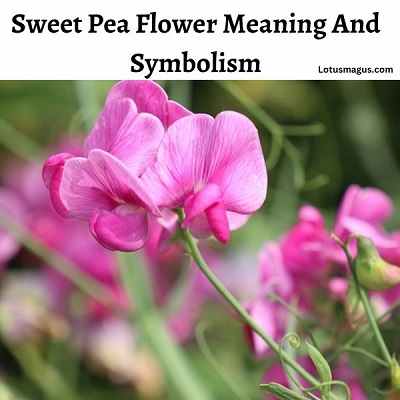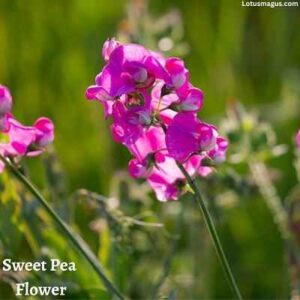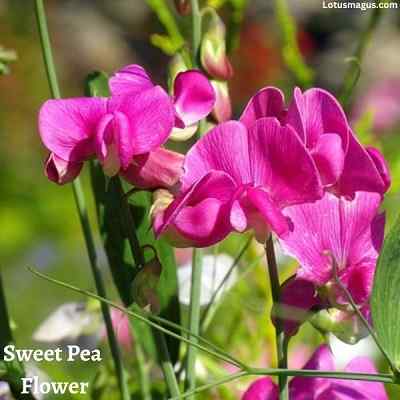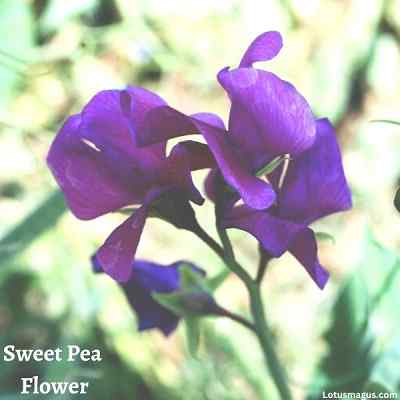Every garden or floral arrangement benefits from sweet pea blossoms. They are attractive and delicate flowers best used in weddings, birthdays, and other special events because of their brilliant colors and delicious aroma. Yet, sweet pea blooms have profound symbolic connotations and a long cultural heritage. In this blog post, we will explore the meaning and symbolism of sweet pea flowers, as well as their scientific name, height, growth, native place, and other interesting facts about the plant.
Sweet pea flower (Lathyrus odoratus) symbolic meaning is exquisite beauty, pleasant enjoyment, enduring pleasure and goodbyes. Sweet pea flowers are also used to show thanks, admiration, and loyalty, making them ideal gifts and tokens of love and friendship. This climbing plant grows to six feet tall and produces beautiful pea-shaped blooms in pink, purple, red, white, and blue. Sweet pea, native to Italy and the Aegean Islands, is now grown worldwide.
Sweet peas often signify “thank you for the nice time.” The Victorian period promoted floral language, and individuals used flowers to convey feelings they couldn’t say. Hosts and hostesses still distribute sweet peas to show appreciation after a great evening or social event.
Sweet peas provide joy and admiration. They symbolize youth and springtime freedom. The flowers’ lovely scent and brilliant blossoms may provide delight to flower lovers.
Sweet pea flower meanings might vary depend on their hue. Purple sweet peas symbolize spirituality and mysticism, while pink ones symbolize passion and adoration. Red sweet peas indicate passion and profound love, whereas white sweet peas symbolize innocence.
Sweet pea flowers’ connotations vary by culture and time. Sweet peas may mean farewell or good luck in different cultures. Sweet pea flowers are loved for their beauty, scent, and capacity to offer joy to others, regardless of their meanings.

| Specification | Information |
|---|---|
| Common Name | Sweet Pea |
| Botanical Name | Lathyrus odoratus |
| Family | Fabaceae |
| Genus | Lathyrus |
| Flowering Period | Spring and early summer |
| Flower Color | A wide range of colors, including pink, purple, red, white, yellow, and blue |
| Flower Size | Typically 2-3 cm in diameter |
| Fragrance | Sweet and strong fragrance |
| Stem Length | Can grow up to 2 meters long |
| Foliage | Pinnate leaves with 2-3 pairs of leaflets |
| Growing Conditions | Prefers full sun and well-drained soil |
| Propagation | By seed or stem cuttings |
| Uses | Ornamental plant for gardens and cut flowers for floral arrangements |
| Interesting Fact | In the 17th century, Sicily brought sweet peas to Europe, which became famous owing to their sweet scent and brilliant blossoms. |
What is Sweet Pea?
Sweet peas (Lathyrus odoratus) are lovely blooming plants with fragrant and colorful petals. In cold marine or mountain settings, these annual plants bloom throughout summer. Sweet peas thrive in cutting gardens, border gardens, forests, trellises, and arches.
These climbing vines feature curling tendrils and delicate pastel and bicolor blossoms. They make beautiful spring and early summer bouquets. Some sweet peas may trail over rocks, fences, or trellises.
Lathyrus odoratus, a legume, grows bushy or climber annually. This plant has winged stems with pairs of medium-to-dark green leaves. The blooms smell delicious, thus the species name odoratus. Sweet peas, a bean family annual, are appreciated.
The annual Fabaceae vine sweet pea is popular. Its beautiful red, pink, blue, white, and lavender blossoms are well recognized. Sweet pea is native to the Mediterranean and Europe but is produced worldwide. As a climbing plant, it may give height to a garden.
Sweet pea grows well in well-drained soil and full to partial light. This low-maintenance plant is ideal for novices. For those who want a fragrant garden, this annual vine offers a pleasant and powerful scent that lasts all summer. It is a great cut flower for floral arrangements that provide color and aroma to any environment.
Sweet pea, a lovely and aromatic plant, is poisonous to people and dogs. The seeds and other plant components contain poisonous chemicals that may cause serious sickness if swallowed. Avoid mishaps by keeping this plant away from youngsters and dogs. Gardeners love sweet pea’s beauty and smell despite its toxicity.
Sweet pea has been a favourite garden plant for ages. It is a great present for friends and family since it symbolizes thanks, joy, and happiness. Sweet pea was a favourite Victorian thank-you gift after a fun evening. Due to its fragrant blossoms and vibrant colors, sweet pea is a favourite wedding bouquet flower.
Sweet Pea Flower Meaning and symbolism
Sweet pea flower (Lathyrus odoratus) symbolize exquisite beauty, pleasant enjoyment, enduring pleasure and goodbyes. Sweet pea flowers are also used to show thanks, admiration, and loyalty, making them ideal gifts and tokens of love and friendship. This climbing plant grows to six feet tall and produces beautiful pea-shaped blooms in pink, purple, red, white, and blue. Sweet pea, native to Italy and the Aegean Islands, is now grown worldwide.
The sweet pea blossom has been a symbol for centuries, with different meanings in different cultures. Sweet peas symbolize pleasant delight. The Victorians popularized floral language, and the sweet pea was connected with gentle pleasure and goodbye. The sweet pea is still used for goodbye flower arrangements because of its symbolism.
Sweet peas symbolize appreciation and friendliness. Sweet peas are a popular floral gift for friends. The sweet pea’s brilliant blossoms and aroma will make everyone happy.
Sweet peas bring luck and joy. In many cultures, sweet peas bring luck and calm to a new house or business. The flower’s nature and capacity to offer pleasure and happiness to any area support this concept. Sweet peas are grown in gardens or given as presents to bring luck and positivity.
Sweet peas symbolize honesty and power. Folklore and beliefs link the flower to purity and fidelity. The sweet pea’s delicate and robust character is said to encourage people to seek truth and strength in their own lives.
The Sweet Pea Flower’s History
Sweet peas (Lathyrus odoratus) once flourished wild in Sicily, Cyprus, and Southern Italy. Father Cupani, a Franciscan friar, found a beautiful bloom in Sicily’s highlands in 1696. He planted the plant in his monastic garden and sent seeds to European organizations and plant collectors.
Henry Eckford, a former chief gardener of the Earl of Radnor, produced grandiflora sweet peas in the late Victorian century, making them famous in England. In 1882, Eckford launched ‘Bronze Prince’. California producers sent trainloads of sweet peas nationwide by the late 1800s.
Sweet peas are adored for their delicate appearance and pleasant aroma. Sweet peas originated in the Mediterranean, where they have enchanted people for millennia.
The Sweet Pea Flower cultural significance
Several civilizations value sweet peas. Victorian England loved sweet peas as a sign of affection and gratitude. Noblemen and ladies used them at big gatherings. Sweet peas symbolize goodbyes and happiness.
Others believe sweet peas may boost spirituality and intelligence. French brides utilize sweet peas for good luck. Giving a lady a sweet pea flower is said to make her love you. Give a lady a lovely white pea blossom to plead for her forgiveness.
Italy and Greece are home to the Mediterranean sweet pea. A traveling Franciscan friar discovered the sweet pea bloom in the 17th century. Keats named it. Sweet peas symbolized Edwardian England.
Sweet peas are beautiful and fragrant, but they also have mystical powers and cultural significance. They provide beauty and fragrance to any garden as climbing annuals.
The Sweet Pea Flower physical appearance
Sweet peas (Lathyrus odoratus) are lovely climbing vines that may reach 1-2 meters with help. These vinelike stems grow 4-6 feet tall and contain complex leaves with two oval leaflets and a terminal tendril that twists and twines around any support. The fragrant blossoms come in several hues, including red, apricot, violet, rose, white, pink, blue, and more. They may reach 5 cm (2 inches) in diameter and mimic butterflies or hummingbirds.
The everlasting pea (Lathyrus latifolius) is a hairless perennial with broad-winged stems that climbs and covers enormous regions. Its lance-shaped leaves sides the stems and petioles, and its blossoms resemble sweet peas but come in fewer hues.
The Sweet Pea Flower habitat
Lathyrus, or sweet peas, are Fabaceae plants with 150 species. Several species are from Sri Lanka, although most are Mediterranean. Since the 17th century, hundreds of sweet pea varieties have been grown for gardens and businesses.
Sweet peas need chilly weather or afternoon shade. They endure cold and heat. Organic materials and mulch keep soil uniformly wet, which plants need to flourish. To maximize growth and blooming, plant sweet peas early in spring in well-drained soil. Seed pods may reduce blossoming.
Everlasting peas grow wild in fencerows, roadsides, railways, fields, and old homesites where they were originally grown. Its large leaves, hardiness, and restricted color variation make them excellent landscape plants.
The Sweet Pea Flower care and maintenance
Sweet peas like deep, chilly, wet soil and sun. Plant low-growing annuals in front to shade their roots. Choose a well-drained alkaline location. Sprinkle powdered lime over acidic soil.
Half-strength liquid fertilizer twice a season keeps sweet peas healthy. They require weekly watering throughout the growth season. Frequent fertilizing prolongs the flowering season, and sweet peas grow and blossom quicker as spring and summer days become longer.
Plant sweet peas in a teepee, arch, or tunnel. Keep the soil wet but not waterlogged for sweet peas. Mulching sweet peas helps retain moisture and cool their roots.
Sweet peas need light, well-drained soil, and frequent fertilizer and watering. To bloom all season, they require a vertical support and mulch.
The Sweet Pea Flower benefits

Sweet pea flower plant is poisonous and doesn’t contain any benefits but similar variety of a plant called Butterfly pea blossom (Clitoria ternatea) is a prominent plant used in traditional medicine. Its vivid blue color is utilized in teas and food coloring. Butterfly pea flowers provide antioxidants and are beautiful.
Butterfly pea flower is known for its weight loss capabilities. Antioxidants in the flower alleviate inflammation and protect against free radical damage. This improves metabolic function, making fat burning and weight reduction simpler.
Butterfly pea flower also controls blood sugar. Diabetes sufferers and those at risk may benefit from its glucose-inhibiting properties.
Butterfly pea flower may improve hair and skin health as well as weight reduction and blood sugar management. Anti-glycation qualities prevent skin aging, making it a popular skincare component. Butterfly-pea flower tea is popular for mood enhancement due to its earthy taste.
Lastly, a Journal of Applied Pharmaceutical Science animal research indicated that butterfly pea flower petals are antioxidant and anti-diabetic. Butterfly pea flower petal extract was shown to manage blood sugar and avoid diabetic problems.
Butterfly pea flower has several health advantages and is flexible. Its high antioxidant content and blood sugar regulation make it a good option for metabolic health. Butterfly pea flower tea or food coloring adds color and nourishment to your diet.
References :
https://www.ncbi.nlm.nih.gov/pmc/articles/PMC6546959/
https://www.ncbi.nlm.nih.gov/pmc/articles/PMC5514576/
https://pubmed.ncbi.nlm.nih.gov/31875951/
https://pubmed.ncbi.nlm.nih.gov/25573272/
The Sweet Pea Flower drawbacks
Lathyrus odoratus, sweet peas, are valued for their fragrant and bright blossoms. Yet, all parts of the plant—flowers, leaves, and pods—are harmful to people and animals. Large doses of lathyrogens from the plant may develop lathyrus. Sweet pea seeds, used for crafts and adornment, contain slightly toxic lathyrogens.
Lathyrus causes paralysis, sluggish pulse, respiratory problems, and convulsions. Sweet pea seeds and other plant components seldom poison. Nevertheless, ingesting huge amounts of sweet pea seeds over weeks or months might cause paralysis.
Due to cross-pollination and hazardous chemical contamination, ornamental sweet peas should not be grown near eating peas, Pisum sativum. Keep sweet pea seeds and plant parts away from children and dogs.
In conclusion, sweet peas are a lovely addition to any garden, but they should not be eaten to avoid health risks.
Reference:
https://plants.ces.ncsu.edu/plants/lathyrus-odoratus/
https://www.childrens.health.qld.gov.au/poisonous-plant-sweet-pea-lathyrus-odoratus/
The Sweet Pea Flower uses
Beautiful sweet peas are useful in gardens and houses. Their tempting hues and perfumes produce gorgeous spring and early summer bouquets, making them ideal for cutting.
Sweet peas compliment other flowers and make great solo bouquets due to their upright growth. They attract pollinators to any garden or food area.
Sweet peas thrive in cutting gardens, border gardens, forests, trellises, and arches as annuals. Its ruffly, romantic look and vast range of colors—from white to coral pink to purple and everything in between—make them essential for every garden.
Sweet peas are great cut flowers for inside and outdoors. Sweet peas provide color and fragrance to gardens and homes.
Sweet Pea interesting facts

Sicilian monks brought the sweet pea, Lathyrus odoratus, to England in the 17th century. Henry Eckford’s cultivation in the late Victorian period made it popular. This annual flower is known for its ruffled pastel, blue, and bi-colored blossoms.
Sweet peas are attractive and useful in the garden. They attract bees and other pollinators to any garden, even food gardens. The sweet pea plant does not yield edible peas like its family members.
Cottage gardeners appreciate the easy-to-grow sweet pea. In cold marine or mountain settings, it blooms throughout summer. Late-Victorian gardens need this fragrant, bright bloom.
Sweet Pea superstitions
Folklore and superstition surround sweet peas. The flower symbolized power and integrity in the past. In France, brides were lucky.
April’s birth flower, the sweet pea, is also associated with March’s St. Patrick’s Day. Planting sweet pea seeds before sunrise on St. Patrick’s Day is said to bring luck and pleasant blossoms.
The sweet pea brings luck and insight. “Hello Darling Pea” symbolizes real love.
Sweet peas have a rich history. They have a rich history of superstition and symbolism that fascinates people today.
Sweet Pea Flower spiritual meaning

For millennia, many civilizations have embraced the Sweet Pea flower’s spiritual significance. This delicate, fragrant flower comes in a variety of colors, from pastels to vivid colours. Sweet Peas are more than pretty flowers. It symbolizes many spiritual concepts.
The Sweet Pea flower symbolizes joy. The flower symbolizes life’s basic joys. It reminds us to enjoy life’s minor pleasures and appreciate the beauty and kindness around us.
Sweet Peas symbolize friendliness, generosity, and good wishes. It’s a common thank-you present. The blossom symbolizes eternal connections and compassion and giving.
Sweet Peas symbolize farewell. The Victorians gave the flower as a goodbye present. It was thought to give farewellers courage and hope for a beautiful reunion.
Sweet Peas symbolize virginity, power, and sincerity. Pure and chaste blossoms symbolize power and endurance. The flower is thought to provide seekers enlightenment and truth, enabling them connect with their spiritual selves and achieve inner strength and clarity.
The Sweet Pea flower symbolizes appreciation, long-lasting connections, and spirituality. To show thanks, friends and family get the flower. It symbolizes the significance of building long-term connections.
The Sweet Pea flower represents many spiritual views and ideals. Its lovely, fragrant blossoms symbolize pleasure, goodwill, and the significance of compassion and thanks. The Sweet Pea flower represents hope, power, and everlasting love, whether given as a gift or merely appreciated.
Final thoughts
I hope you get the answer on “Sweet Pea Flower Meaning”. Lastly, about sweet pea, the blooms are more than attractive. They have centuries of cultural significance and symbolic importance. Sweet pea blossoms make great gifts or yard decorations. They will wow recipients with their exquisite beauty and fragrant scent.
Speedwell (Veronica) Flower Meaning – Spiritual Symbolism, Colors
Willow Tree Spiritual Meaning : What is The Symbol Represents?
